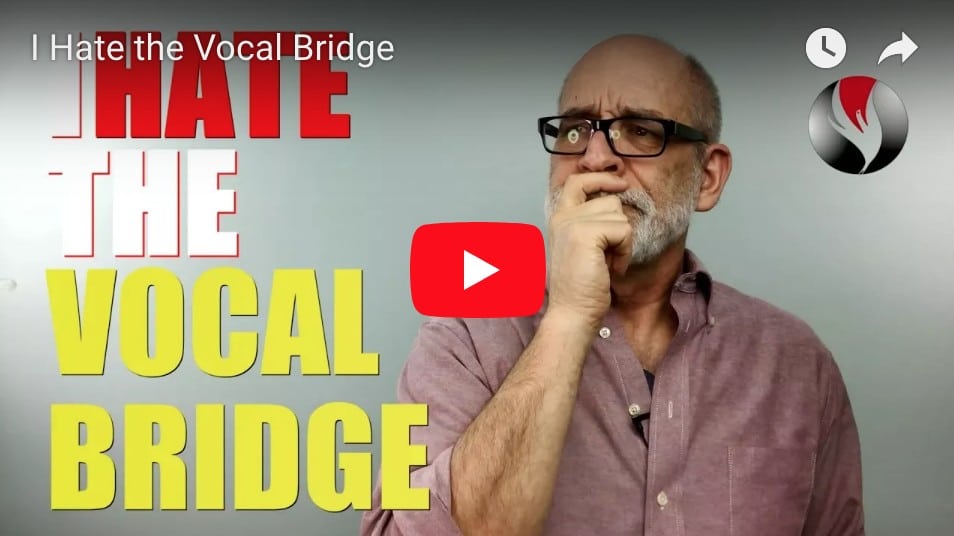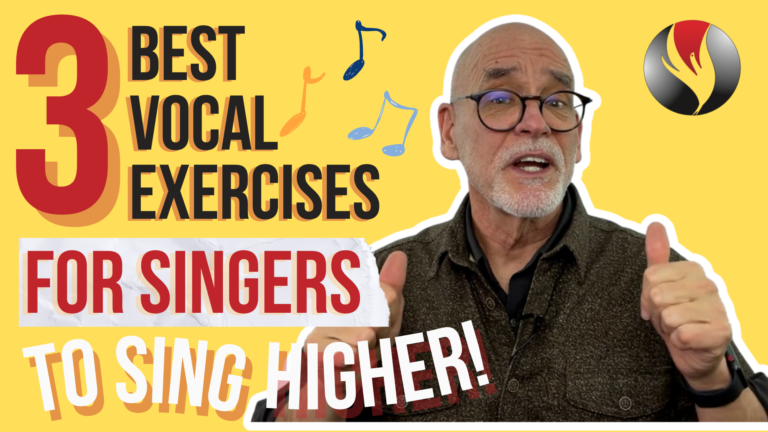Recently I received a comment that began with , “Oh boy, do I hate the vocal bridge”. Then later he said, “… getting through the bridge is murder”. Inside this video, I’ll talk about why singers hate the vocal bridge, why it can be murder, and how to fix it!
The vocal bridge, which is sometimes called the passaggio or my break, is located in the same place for every singer.
Women feel the bridge at A4 (the A above middle C), Bb, B and C5. Women who can sing low notes like the C or D below middle C probably bridge where the tenors and baritones bridge, which is the E4 (the E above middle C), F, and F#4.
True basses and contraltos bridge one bridge lower than the tenors and sopranos.
Virtually every voice experiences the above bridges. Some gifted singers never have struggled singing in or through the bridge. The rest of us average mortals are very challenged by the bridge.
Why Singers Hate the Vocal Bridge
The bridge is the place in the voice where the resonance and vibrations made by the vocal cords shift from the chest voice into the head voice. The vocal cords are also making an adjustment. It feels weird and uncomfortable.
We panic, the larynx goes up, the voice jams up, the extrinsic muscles of the neck tighten and then our voice cracks. Or we push harder until we’re yelling and straining and the pitch goes flat. Or we just break into falsetto.
This is why so many singers hate the vocal bridge! We end up picking songs that don’t require us singing in the bridge. The trouble is, most of our favorite songs require us to sing in, through or above the bridge.
If you don’t know how to bridge, it’s murder when the high note lands in or above the bridge. Just when you want to be impressive, you crack, or go flat, or flip into falsetto or strain and splat the word. Or you have to go breathy and light…so it sounds like two different people singing.
How Singers can Learn to Love, Not Hate the Vocal Bridge
The good news is, there’s nothing wrong with your voice. You just don’t know how to bridge. Here are three vocal exercises that will help you begin to feel the bridging process.
First an exercise to help you keep the larynx down while the vibrations move into your head. It’s both simple and profound. It’s called Bubble Lips. Using a 5 tone scale, men start on the G below middle C and and women begin on middle C. Both voices travel up 6 half steps and back down again like this. [Demo]
Notice the feeling of the vibrations shifting up into the head and back down. Don’t let your voice crack while doing the exercises.
Second, here’s an exercise that will thin or lighten the chest voice but keep the tone connected so you don’t break into falsetto. It’s called the Bratty Ney. Do this exercise using the same scale and notes as before. [Demo]
Do this with medium to light volume at first. Doing it lighter will discourage grabbing the tone like this. [Demo] The larynx is slightly higher but not enough to hurt the voice.
Third, is an exercise that will lower the larynx. It’s called the Dopey Gee. It will help keep the larynx down while the vibration shifts into your head. It also keeps the tone connected as you sing through the bridge. Do this exercise using the same scale and notes as before. [Demo]
Be sure to keep that dopey sound as you sing higher. If you do it will sound hollow or hooty like this. [Demo]
Once you’re able to sing through the bridge without strain, breaks or breathiness, you can discontinue the bratty and dopey sounds.
These exercises will create a new sensation in your voice. It’ll be awkward at first. It won’t be a finished sound ready to use immediately. But it will help you know it is possible to learn to bridge.
Knowing you can learn how to bridge and sing with your full voice into your head voice easily and confidently is life changing. [ Ah Demo]
If you liked this video, please give it a thumbs up, subscribe and share it with a friend. Have you learned to bridge? Let me know in the comments section below. Also, be sure to join me on Twitter, Facebook and Instagram @PowerToSing.
Get Special Exercises for Your Vocal Type so You can Bridge Rapidly
You can learn to bridge rapidly if you know your vocal type. Do you know your vocal type? Your vocal type describes what you tend to do when you sing through the bridge into your head voice.
Go to PowerToSing.com and take the vocal test which I call the PowerTest. Take the quiz and discover your vocal type.
Then visit the Knowledge Center and watch the videos about your vocal type. Download the free exercises for your vocal type. These exercises include those covered in this video and are designed for your vocal type and will enable you to learn to bridge quickly. Download them today.
I’m Chuck Gilmore with Power to Sing. You can sing higher with beauty, confidence and power.
I’ll see you inside the next video








Responses